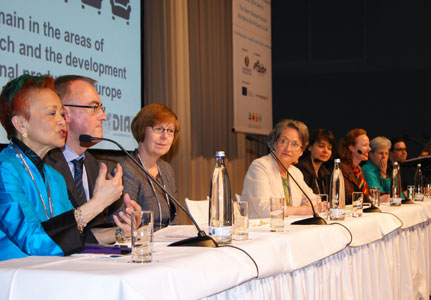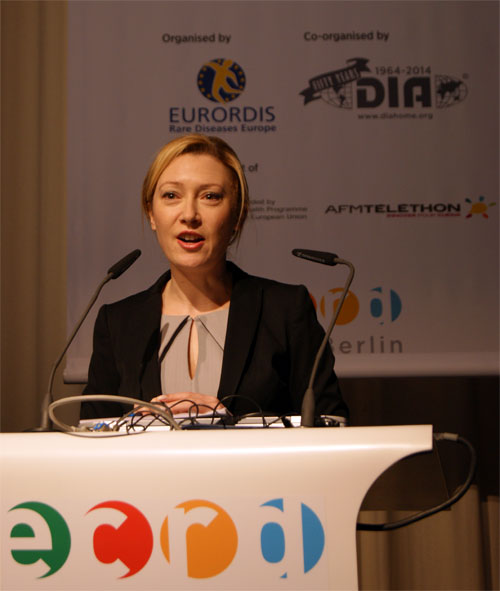ECRD 2014 Berlin: Putting the rare disease puzzle into place
 The 7th European Conference on Rare Diseases and Orphan Products ECRD 2014 Berlin on 8-10 May brought together over 750 stakeholders – patient representatives, health professionals, scientists, industry, policy makers, regulators, payers – converging from over 40 countries in the lively city of Berlin. The biennial ECRD is the unique platform to debate and steer rare disease policy across all rare diseases, across all European countries and beyond, and across all stakeholders. As always, it provided the state-of-the-art and trends of the rare disease environment including initiatives and breakthroughs. With a great sense of unity and responsibility, participants fostered a true international exchange of experiences and ideas, bringing the picture of “The Rare Disease Puzzle” to life.
The 7th European Conference on Rare Diseases and Orphan Products ECRD 2014 Berlin on 8-10 May brought together over 750 stakeholders – patient representatives, health professionals, scientists, industry, policy makers, regulators, payers – converging from over 40 countries in the lively city of Berlin. The biennial ECRD is the unique platform to debate and steer rare disease policy across all rare diseases, across all European countries and beyond, and across all stakeholders. As always, it provided the state-of-the-art and trends of the rare disease environment including initiatives and breakthroughs. With a great sense of unity and responsibility, participants fostered a true international exchange of experiences and ideas, bringing the picture of “The Rare Disease Puzzle” to life.
The Rare Disease Puzzle
This seventh edition of the ECRD looked at putting into place the different pieces of the rare disease puzzle that have been identified over the past twenty years and which were woven throughout the six overarching conference themes: Improving Healthcare Services; Knowledge Generation & Dissemination; Research from Discovery to Patients; State of the Art & Innovative Practices in Orphan Products; Emerging Concepts & Future Policies for Rare Disease Therapies; and Beyond Medical Care. Over a rich and intense two days, the various elements of these topics were presented, discussed and debated via 36 dedicated sessions spanning the six general themes. The only problem was choosing which sessions to attend!

The ECRD 2014 Berlin Opening Session kicked off with remarks from Avril Daly (Fighting Blindness Ireland) and Jytte Lyngvig (DIA), followed by keynote addresses from Annette Widmann-Mauz (Parliamentary State Secretary, Federal Ministry of Health, Germany) Christoph Nachtigäller (ACHSE), Irene Norstedt (European Commission) and Lesley Greene, (CLIMB). The rare disease national strategies were evoked, with a presentation of the German plan that was adopted in August 2013.
The Plenary Session further ignited participants as a special four-minute presentation captured the history, progression and status of the European rare disease movement, setting the tone and putting everyone in the right frame of mind to continue the onward journey to bring treatments, resources and information to people living with a rare disease across Europe and beyond. Anchored by Durhane Wong Rieger (CORD) and featuring a presentation from John F Ryan (European Commission), the Plenary Session took stock of the impact of the EU Council Recommendation on an action in the field of rare diseases and gave an overview of the challenges ahead. It was reiterated that the regulatory framework for rare diseases is well developed in Europe and the challenge now is to ensure that current and future policies and initiatives optimise existing regulations as fully as possible.
Indeed, as more countries develop and implement strategies for rare diseases, stakeholders are working hard to develop the resources these strategies embody, including the Centres of Expertise and European Reference Networks for rare diseases. There were well-attended sessions devoted to best practices for developing, operating, designating and evaluating the Centres of Expertise and European Reference Networks. As European-level agencies prioritise rare diseases in their funding strategies, and industry puts more rare disease treatments into the developmental pipeline, sessions on initiatives to ensure that patients can access rare disease treatments as they become available also drew big crowds. Dedicated sessions on Progressive Patient Access Schemes, Patient Involvement in Benefit-Risk Assessment, Mechanisms of Coordinated Access and Transparent Value Framework, Managed Entry Agreements and other emerging ideas for sustaining access to orphan medicines were well attended and discussions were rich, if at times complex. Throughout all sessions, patients and patient representatives played a prominent role, sharing their experience, challenges and needs. An informal show of hands in various sessions showed that audiences were evenly distributed, with equal representation from all stakeholder groups present. Thus, in a session on orphan medicine development, for example, when certain patients stated that they don’t want placebos in trials for progressive rare diseases for which time is of the essence, members of industry and academia were present to hear and absorb the patient perspective.
ECRD: a source of empowerment for all
As a venue for all stakeholders to share their needs, experiences and challenges, ECRD 2014 Berlin empowered participants by furthering information and understanding on emerging initiatives, such as the mechanisms to facilitate access to treatments, coding of rare diseases in health systems, registries for rare diseases, the role of the media in rare disease promotion, the role of patients in treatment development, medicine shortages, addressing unmet medical needs, rare disease social challenges, fostering autonomy and independence. As Elizabeth Vroom (United Parent Projects MD, Netherlands) pointed out in the session on How to Shape a Better Framework for Orphan Drug Development: EMA/FDA Collaboration, when it comes to rare diseases, all stakeholders are in a learning curve – patients, scientists, industry, health professionals, regulators, payers. We are learning as we go along, and we are learning from each other.
There were many excellent presentations made during the conference and these are now available online. Amongst many distinguished Chairs and Speakers at ECRD 2014 Berlin were Stefan Schreck, Head of the Health Information Unit at DG Health and Consumers, European Commission; Irene Norstedt, Head of Unit, Personalised Medicine, DG Research, European Commission; Paul Lasko, Chair of the International Rare Disease Research Consortium (IRDiRC); Jordi Llinares Garcia of the European Medicines Agency; and Greet Musch, Director General of Pre-authorisation – Federal Agency for Medicinal and Health Products Belgium.
As always, ECRD 2014 Berlin provided simultaneous interpretation of key sessions into French, German, Polish, Russian, and Spanish. Other popular features of ECRD 2014 Berlin included 200 posters on display for browsing and discussion and which are now available online; the numerous informal networking opportunities available throughout the event; the freely available App for iPhones and Android that offered full access to the conference programme and posters; the Twitter wall that displayed live #ECRDBerlin tweets from the ongoing Twitter chat on a large monitor in the conference foyer; and photographs from the Hungarian Rett Syndrome Foundation and the EURORDIS Photo Contest that were displayed on a monitor throughout the event.
The next ECRD will take place in 2016 in Edinburgh – we hope you will be able to join us!
In the meantime, enjoy the Photos from ECRD 2014 Berlin.
Louise Taylor, Communications and Development Writer, EURORDIS
